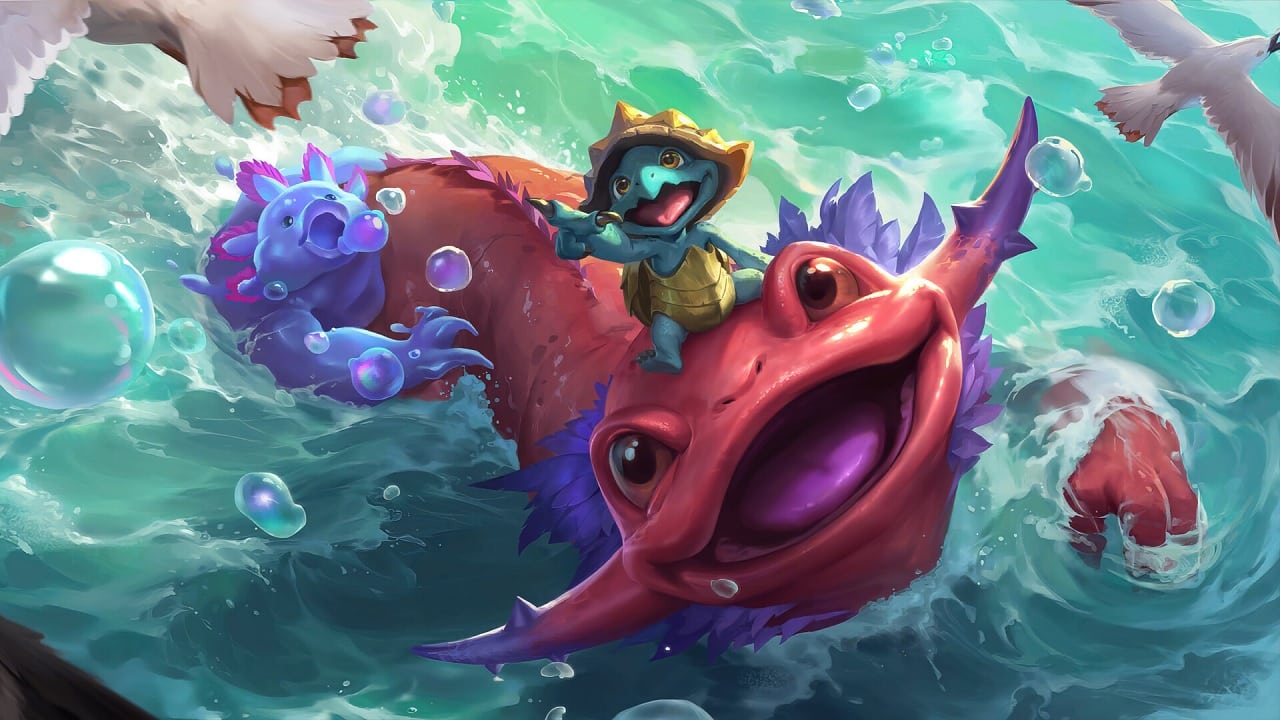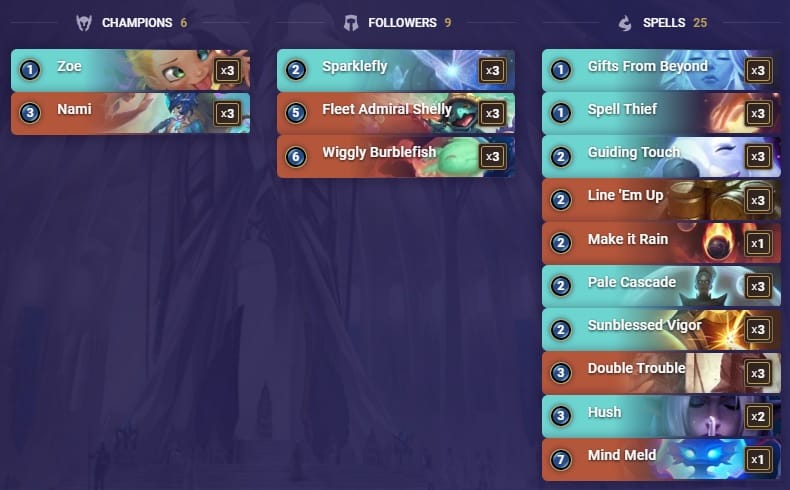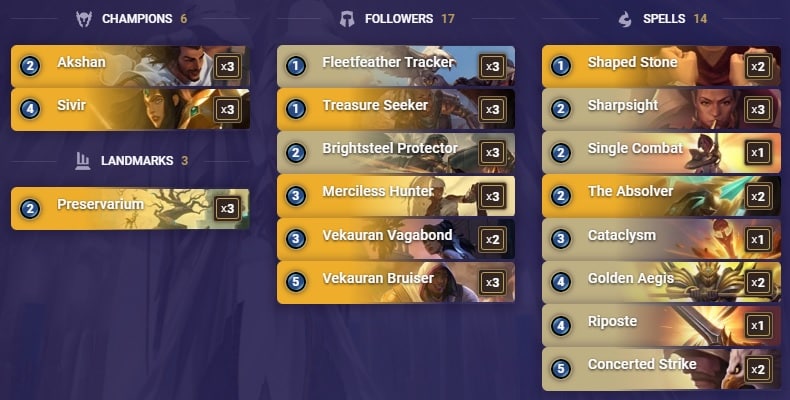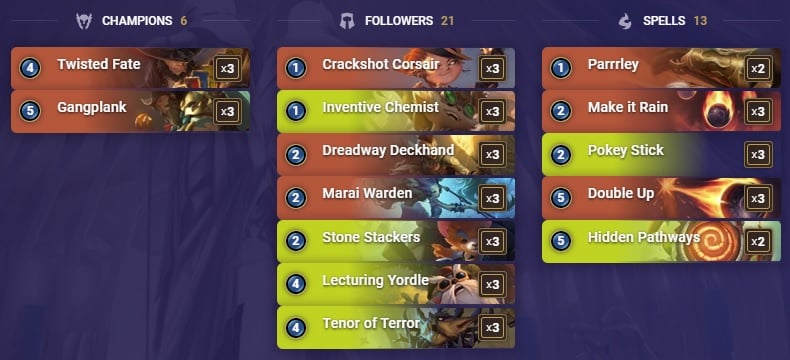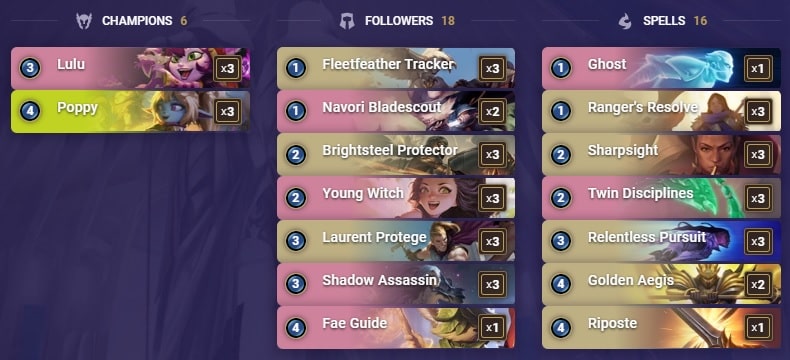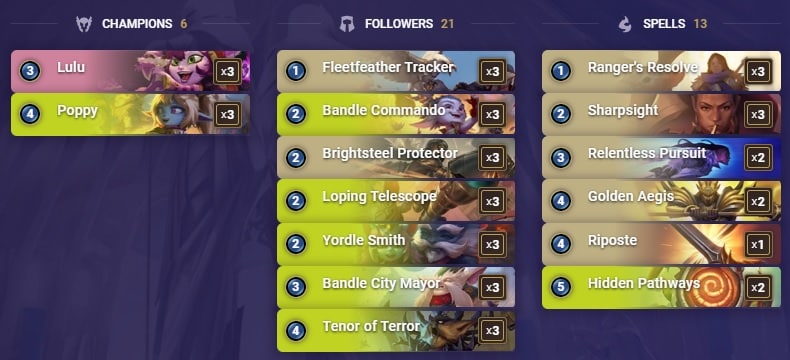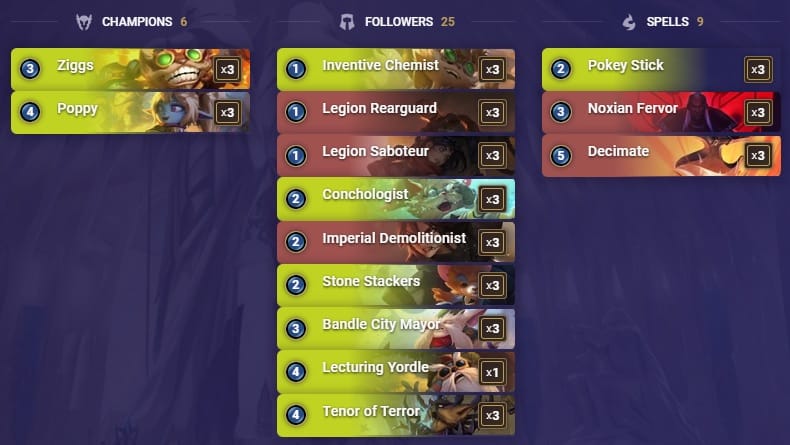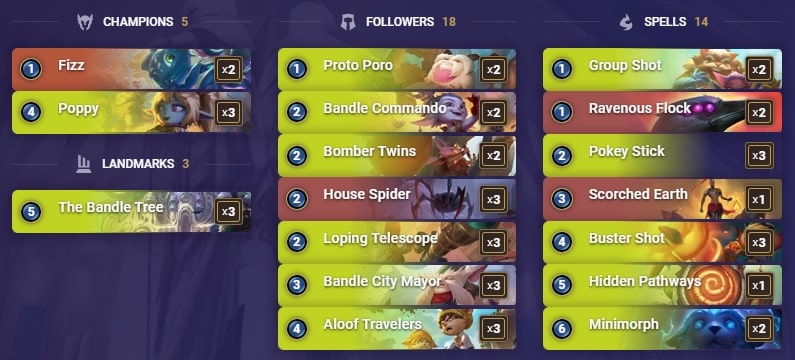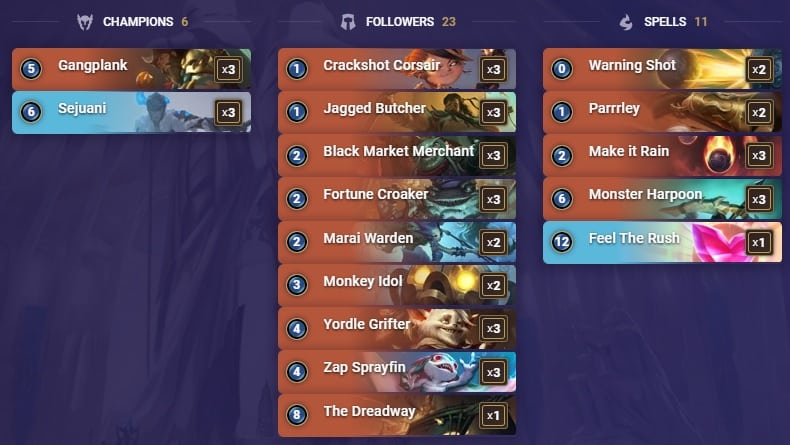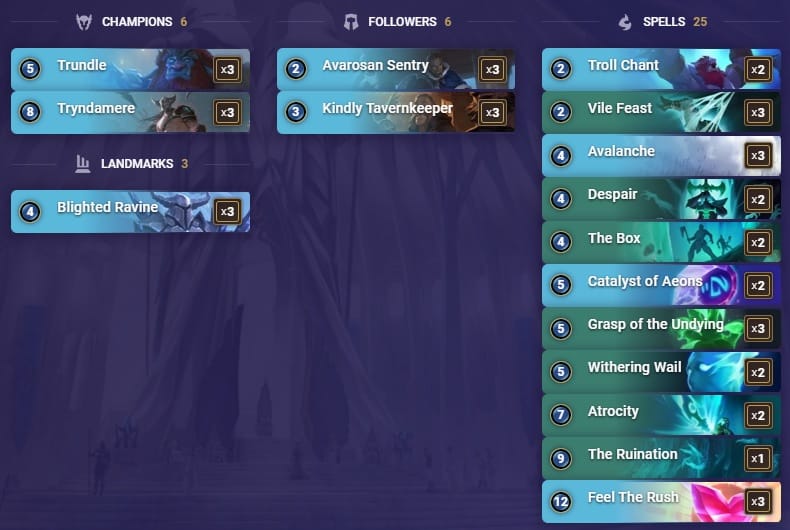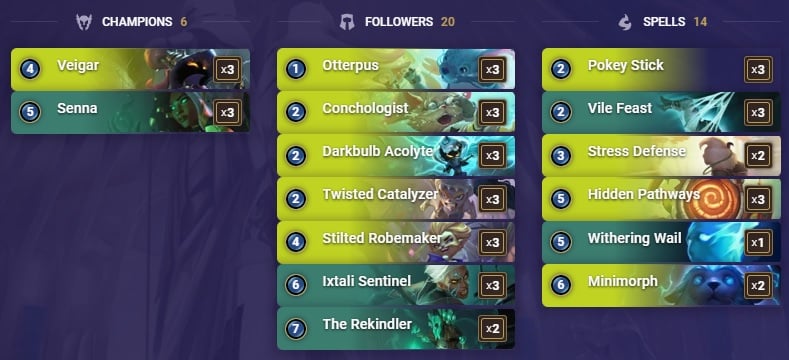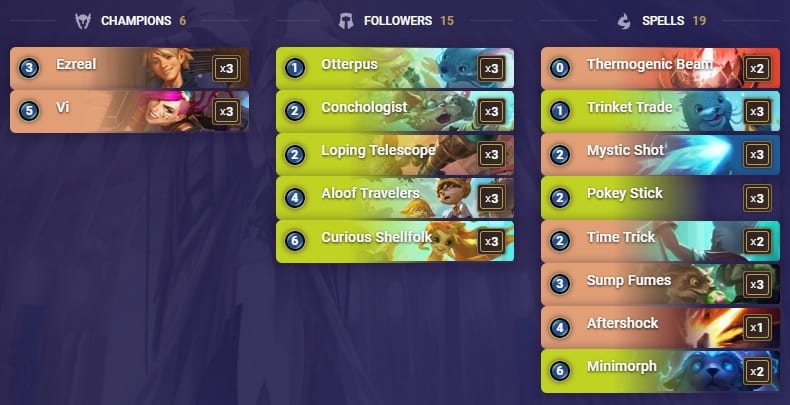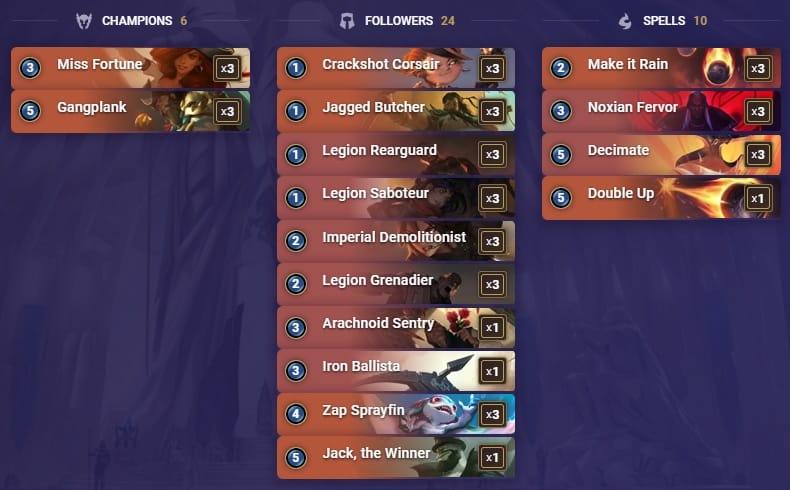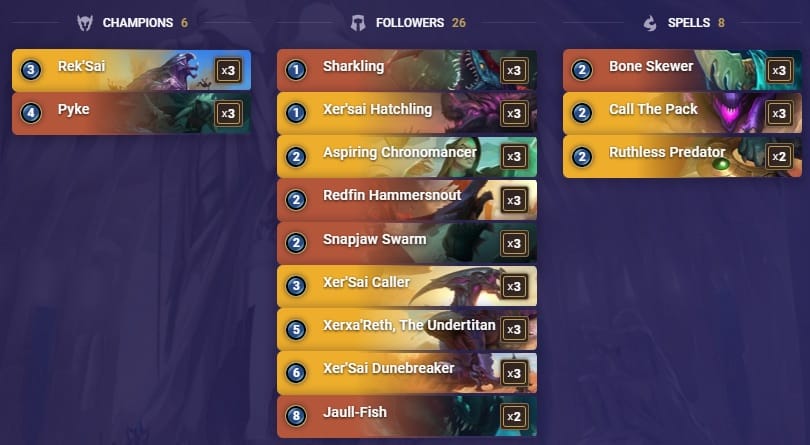Welcome to TLG’s latest meta snapshot for Legends of Runeterra, a series in which we give you our insight on the finest decks in the higher ranks of the ladder.
Every Monday, we discuss the decks that are part of the week’s meta and rate them on a scale of 1 to 5 stars. We also look at the evolution of said decks’ ratings across weeks and draw conclusions regarding the current state of the game, all of this so you can delve into your own ranked journey with a head start.
The World Championship has been and gone, with Alanzq coming out victorious. Whether you tuned in or not, it had a huge impact on the ladder environment. Alan’s Curious Shellfolk list has entered the fray, along with a new take on the Darkness deck popularized by the runner-up, Yamato.
Some new Burn decks have appeared too, such as Bandle Gangplank and Ziggs-Poppy, putting the trusty old Pirates in their place. GP-Sejuani is back, alongside Feel The Rush. The newcomers and returners are very welcome, as the apex of the meta is the now-familiar trio of Zoe-Nami, Sion Discard and Akshan-Sivir.
If you have any questions, feel free to drop by our Discord. Best of luck on your climb!
Graphics: WellMax81
Editing: Wusubi, Sebodunum
Writers: Den, Ultraman, Othal

CICQCAQGDAAQGBQRAECAMDQCAUDAKCYHAMEQSIZIFIZWFVYBAEAQGCKVAEBAEBRKFU
Difficulty: Moderate
If you want to relive the glory days when My Chemical Romance and pirate metal were walking hand in hand on the ladder of Runeterra fear not: you can now feel the same sensations, just with 89% less edginess. Aphelios and Twisted Fate are gracious losers and leave their place to the more feminine team of Zoe-Nami. It’s currently the best deck in the meta, due to its favored matchup into Sion Discard and the sheer power of free stats provided by Nami.
This list has a simple game plan and a lot of options. While you’ll usually just try and survive the early game to build a board of Elusives you can boost with Nami, this deck provides answers for most matchups. Against Aggro decks, you can use Sparklefly to get some free healing every turn. Against Midrange decks, abuse Nami to get the biggest units possible. You’ll suffer against control decks though, so stick to the plan and get to winning!
Leveling Nami is the most important task, so you’ll need to manage your spell mana carefully: if your reserve is full, you won’t gain more spell mana and thus will be stuck. But if you use only spell mana and don’t play creatures on the board, you’ll open yourself to threats and direct attacks while also slowing your win con, which is making the enemy Nexus explode.
Zoe is here to help you get early pressure, some low-cost spells to empty your spell mana reserve, and also some much-needed flexibility from her pool of Celestial Cards. Getting her to level-up isn’t necessary, so don’t focus on keeping her alive when Nami has a bigger impact on your strategy - alhough having a board full of Lifesteal Elusives thanks to Sparklefly is a joy known only to a few chosen ones. (Write-up by Othal)
CECACAIDCQAQIBAQAQAQIJRHFU2AIBIDAECAMDIEAEAQIAIBAMBQ6AIDAQJACBIDBEBACAIDEMAQGAYN
Difficulty: Moderate
Sion Discard rose as one of the top tier decks almost immediately after the expansion, mostly countering Demacian archetypes. How is it faring after the nerfs, you ask? Despite facing less Akshan-Sivir and having to deal with a new challenger in Zoe-Nami, it remains one of the top contenders, after adapting to the rest of the field.
The list gives you many options. It can play as an Aggro deck, dealing a lot of damage on Turn 1 and 3, before finishing off the opponent with Get Excited! or Mystic Shot. It can also play slower, aiming to keep building up pressure until Sion reaches the board to seal the deal.
But those options aren’t mutually exclusive, and you can use both in the same game! It’s even what you usually aim for, forcing the opponent to go to great lengths to protect themselves from the early aggression, while still retaining tempo and removals to deal with Sion. Even if they do all this, they still have to win before you draw another Sion.
It’s a deck that looks easy on paper, but is in reality difficult to master. The fact that it has a lot of potential for techs, plays and alternative win cons makes it likely to have serious longevity in the top tiers. (Write-up by Ultraman)

CEBQEAIABEOQMBAHBUKDMZ4BAGBACAIDAAHAGAYEA5OYAAMKAEAQIAACAEBAAAICAIAQAGRFAECAAAY
Difficulty: Moderate
As proven by their presence at Worlds, Akshan-Sivir haven’t breathed their last! Due to the nerfs and the evolution of the meta, they had to adapt their list, but the gameplay still revolves around the same principles of aggression and board control.
Shurima/Demacia is a potent pairing, with combat tricks and removals aplenty to deal with backrow units like Nami and Shelly. Board dominance should be easy to assert through the sheer number of challenges you can issue utilizing Fleetfeather Tracker, Merciless Hunter or Cataclysm.
The game plan is simple: to crush your enemies and to hear the lamentation of their women. Everything in your deck is a threat that your opponent won’t be able to value trade with thanks to your Challengers and combat tricks, and each piece of damage you deal goes towards leveling-up Sivir.
Use Golden Aegis wisely, and remember that Cataclysm procs an Attack and not a Strike, so damage from Overwhelm works! Akshan may look a bit out of place, but he’s an incredible value tool, providing you with a trigger for Shaped Stone while acting as a draw engine and a Quick-Attack threat.
The addition of Vekauran Bruiser provides some surprise effect, as well as another source of keywords for your leveled-up Sivir, and thus to your whole board. The Absolver can also help you set-up a rather deadly Open Attack by giving your whole board Overwhelm at Burst speed, and is a good stand-in for the infamous Ruin Runner. (Write-up by Othal)
CEBQCBIGAECQKCQHIVEWBJQBAYBAMBA2D4QC2PACAEBAMEQBAUFBUAA
Difficulty: Easy
Born during the last week of EU Masters qualifiers, as players were looking for quicker options to grind the ladder, Bandle GP has slowly become a staple in the current meta and can brag about having a good matchup into most board-oriented decks. There is one problem, though, which is gatekeeping it out of Tier 1 contention: it’s really bad against Zoe-Nami.
Its board-centric, damage-oriented game plan is great against most decks, and we can see an above 55% win rate against the Demacia decks of Poppy or Sivir, while also being a viable option against all the decks without healing options.
Compared to most Burn lists, this one separates itself from the pack due to its removal capacity, which helps it to leverage the board against most decks in the early game, even if it is limited to targeting low health units. Twisted Fate, Powder Kegs and the cheap spells like Make it Rain or Pokey Stick are strong against all the unit-centric decks.
Another difference with other Burn decks is the way to deal the maximum amount of damage. Unlike many Aggro decks, there is no 3-drop champion to be found here - our best cards are for later in the game. As such, some matchups will push you to take things a bit slower and work towards setting up the board before going down the Burn path. The aim in these cases should be to set up in the early game to allow the big hitters such as Gangplank or Tenor of Terror to be played safely.
As Zoe-Nami shows it, though, Bandle GP struggles against decks that don’t rely on flooding the board to achieve victory, and once a unit gets over 3 HP, it can be much tougher to remove for this deck. Decks which have access to healing and can afford to lose the board in the first few turns are looking to be the natural counters, which makes Lee Sin and Feel the Rush additional decks that you would want to avoid.
It might still be a bit early to know if the deck will keep rising and could enter the Top 3 in terms of power level, especially with the first 2 spots looking locked (barring nerfs) and the great showing of Akshan-Sivir at Worlds. For now, Bandle GP might be better utilized in a tournament setting, as once it’s protected by a ban, it’s extremely difficult to target without bringing a very committed line-up against it. (Write-up by den)
Ionia splash
CEDACAQAA4AQGAAOAECQUKICAEBAYOICAMBAECQEAEAASCYVDUBACAICCEAQIAACAMAQCAQWAEBQEAYBAEACK
Difficulty: Easy
Although it hasn’t reached Tier 1 yet, Lulu-Poppy is a duo that has been very stable in the meta since Bandle City has arrived. Currently, you might see iterations of the Ionia deck using Zed instead of Lulu with some heavy Elusive packages, which is a more aggressive and punishing take on the archetype.
When Sion Discard was at the peak of its popularity, Lulu-Poppy couldn’t really shine. The deck lacked some sustainability to fight against the other explosive early game decks, eventually running out of steam. However, now that Nami decks are on the rise to counter Sion, the environment might be perfect for Lulu-Poppy to reach their full potential.
We’re including two different variations of the deck, splashing Ionia and Bandle City as the supporting regions. Although both lists rely on the same base concepts (namely, developing the board with a numbers approach and punishing opponents who can’t keep up through Rallies), there are some differences in the way they apply pressure.
The Ionian version relies on a better survivability for the key pieces, with the addition of Twin Disciplines and Elusive keywords helping Lulu and Poppy stay alive. The deck feels great if we draw our champions and keep them healthy. A leveled-up Poppy, for example, will more often than not win the game for us. (Write-up by den)
Bandle splash
CECQCAQAA4AQGAAOAEBQEAQCAEAASHIGAUFCSYDUU4A26APLAEBQCAIACUAQIAACAECQUGQBAEAQAJI
The Bandle City side of things isn’t so keen on protecting its soldiers. Instead, the region relies on generating a ton of them to keep the opponent on their toes. By extension, the champions aren’t as protected as in the Ionia version. However, Bandle City makes up for this by having dangerous units. For example, an unanswered Bandle City Mayor can win you the game.
Overall, I would consider the Ionia list to be more well-rounded currently, but the Bandle deck has the upside of being better against removal-based decks, as it can create cards and delay the point where the pressure would let up.
CEBQEAQDAMCAGAIDAIGCQCAFBIDSSMKJMB2KGANGAEAACAIFBJCQ
Difficulty: Easy
Ziggs-Poppy isn’t a difficult deck to grasp, and that’s precisely the point of the list. During the last day of EU Masters qualifiers, players out of reach of qualifying places needed a fast deck to get a ton of games done with the few hours they had left to play. This odd combination of champions is united in one thing: putting the opponent under a crazy amount of pressure.
In the deck, Ziggs simply is the best 3-drop available, rocking a 3/4 statline with guaranteed damage to the opposing Nexus whenever he attacks. Draven might be better than him, but he’s busy carrying 2 other archetypes already...
Poppy seemed weird at first, as an opponent that was unable to remove our early game would crumble under the amount of damage they would take in return, making her an overkill champion. But alongside Tenor of Terror and Bandle City Mayor, she represents the possibility to rebuild your board after the first wave has been cleared. This is something most Burn decks aren’t capable of, usually switching to direct damage once their units have been dealt with early.
That second wind is something that separates this list from other aggressive decks currently, as it’s able to pressure for a much longer time than something like a Pirates deck would, for example. The other reason it got so popular is the over 60% favored matchup into Zoe-Nami, the most played list during the last days of EUM qualifications.
The problem with the deck is the Discard matchup, as this one looks to be too complicated to overcome. Once featured in a ban format though, Ziggs-Poppy could rise atop some tier lists, and even on ladder, Sion is becoming less popular, as he can’t seem to fix its bad matchup against Zoe-Nami. (Write-up by den)
CQBACAIDG4DQKCRJOSCADGABUYA26AOCAEBQCAQGFYAQEAYJAUCQUANAAGTQDQABYYAQEAIDAMGQCBIKDI
The Bandle Tree has been experimented with a lot since the expansion release. Many players can see the potential of the card, but there doesn’t seem to be a proper consensus on what the best 40 cards are for the deck. For now, it looks like at least one question has been solved: Noxus is the best region to pair with Bandle City for this purpose.
Noxus is the better choice over Bilgewater due to its access to removals. Ravenous Flock is extremely easy to activate in a deck that has the most small blockers to date and Scorched Earth wins the mirror match by destroying the opponent’s landmark, while acting as removal in other matchups.
The other thing Noxus has in its locker is House Spider. This simple 2-drop was quickly identified as a highly synergistic card with the archetype. It not only summons 2 regions for The Bandle Tree (the 1/1 Spiderling being a Shadow Isles unit), but also gives more targets for Poppy to buff and can help set up the Noxus-based removal mentioned earlier.
Compared to the previous iterations, the list now has more interaction with the opponent, while still possessing the high-roll potential of a Bandle City Mayor or a Poppy pressuring the opponent for a lot of damage. This more balanced take on the deck fares better in a meta that tends to favor pressure instead of control decks.
The switch towards Nami decks could be an issue for The Bandle Tree, even with Noxus helping in the matchup. It might be necessary to wait for a more defensive environment to see this deck rise atop the rankings. Until then, let’s consider it a nice middle of the pack deck that, like Tahm-Soraka, is based around an enjoyably different win condition through its landmark. (Write-up by den)
CICACAQBAIAQGBQIAECAMCQHAIDAWIBBEYWTUPACAECQMAIDAIDBEFBCAIAQEBQCAEBQCFQ
Difficulty: Moderate
Kind of absent from ladder recently, Plunder came back in several line-ups at Worlds and reminded a lot of players why it can still be a decent deck. Although not on par with the very best decks on ladder, the popularity of board-centric decks makes Plunder an interesting choice to punish them, as both of its champions still pack a considerable punch.
The fast-paced ladder environment is something the deck still needs to adapt to, though. The recent arrivals of Ziggs-Poppy and Bandle Gangplank, for example, are difficult to handle for Midrange decks without healing capacities. In those matchups, Plunder can answer the board, but can’t stop the flow of damage, having to resort to a race in which it’s the slower contestant.
During Worlds, we also saw the rise of some quite unexpected control decks with Darkness and Feel The Rush having a great showing during the tournament. This could be good news for Plunder, as the deck is much better in those slower matchups, where it can develop its game plan and pressure the opponent for an extended period.
Including 1 copy of Feel the Rush is something that two American players decided to play during Worlds. Replacing a copy of The Dreadway, the card can change the dynamic of the late game, allowing you to use spells more liberally. That’s because you don’t need to save up spells until you have The Dreadway on board in order to maximize its ability.
Mixing those threats might be what will save Plunder in this meta, as being able to pressure the opponent is Plunder’s saving grace in a lot of matchups, especially the slower ones. The deck needs to solve one problem now, however; Aloof Travelers is a veritable menace to this deck, as it consistently removes your champion or one of the finishers. (Write-up by den)
CIBQCAICBQBAEAQDAYCQGCIJDMRTHVYBAQAQGAQUAEBQSVIDAEBAEMJZAMBAEBIIBEAA
Difficulty: Hard
While the naysayers proclaimed the death of Lee Sin with the introduction of Aloof Travelers and Minimorph, the Blind Monk proves that his title spell might have to be renamed Phoenix’s Rage as he rises once again and finds his place on the ladder!
After his quick dalliance with Akshan, he went back to his best pairing to date: Zoe. With a slow game plan and a hard set-up being Lee Sin’s trademark, Targon provides the necessary tools to survive the early game in the form of Gifts from Beyond, accompanied by Eye of the Dragon.
Targon also brings its fair share of draw engines like Guiding Touch, Pale Cascade and Zenith Blade, aloing with flurry of cheap spells to help you proc Eye of the Dragon and Deep Meditation. Hush is a decent addition in the current meta, preventing Sion from coming back to life, turning this 10/10 Elusive/Lifesteal unit back into a 2/1, or making sure Ezreal doesn’t crush our Nexus.
Ionia brings its own fair share of tricks, with cards like Twin Disciplines and Concussive Palm allowing you to choose your own battles, protect your key units or slow down the game to your own tempo. You can even boost a Dragonling to get a bigger Lifesteal and get back in the game.
While the matchups against Bandle might still prove difficult, have faith in the dragon spirit and remember that struggle is another step on the path to greatness. (Write-up by Othal)
CECACBABBYBACBJIGYBAGAIGCYCACAIDCQTTEBABAEAQYAIDAEBACBAFDUBQCBITDEOQCAIBAUHQ
Difficulty: Easy
So, you like dancing to K-Pop tunes, but still want to be a shining (and half-naked) beacon of masculinity? Good, because these aren’t incompatible - play Feel the Rush! A staple combination of the meta when Burn and board-centric decks are rampant, Freljord/Shadow Isles is back again and ready to SMASH.
One of the great strengths of the deck is also one of its weaknesses: its straightforward game plan. As always when playing this region combination, you’ll try to stabilize the early game with your board removals like Avalanche and heal yourself back up to make sure you live to see a Turn 9 with 3 spell mana so you can play your win con.
Even if you can switch gears with Catalyst of Aeons, prevent your opponent from going wide for a turn due to Blighted Ravine, or even play Kindly Tavernkeeper as a tempo unit instead of a healing tool, you’ll have a hard time winning without FTR and next to no chance at all without at least a Tryndamere on board.
But in general, the longer the game goes, the better off you should be. The lack of hard removal like Vengeance and silences in decks at the moment makes dealing with a 10/10 Trundle and Tryndamere really difficult, and their Regeneration and level-up (respectively) should help you keep them alive long enough to hit the Nexus like a truck. A really angry, manly and cold truck.
Timing is key when playing this deck, as playing an Avalanche too early might waste your board clear and allow your opponent to go wide again… But not playing it at the right time might result in an attack straight to your Nexus. Same goes for The Box, as a clever opponent might just pass and not let you destroy the units he summoned this turn.
All in all, Feel the Rush feels more like a tournament deck and might have great results there, as proven by Szychu who placed third at Worlds. However, on ladder you have no control over the matchups you’re going to face. A lot of Bandle City cards will be very painful - yes, I’m talking about you Aloof Travelers - while some other late game decks might come online a turn or two earlier than you. (Write-up by Othal)
CEBQQBIKAQNDCOK5LZRKMAIBAECSQAQFAUEASAQCAUFADUIBAEAQKFABAEAQKHI
Difficulty: Hard
Darkness remains something of a struggling deck on ladder. This is down to the fact that you have to be perfect every step of the way against most opponents in order to win consistently. That’s usually enough to make players give up on the deck and choose an easier deck to climb with.
However, during Yamato’s run as the runner-up for the Worlds tournament, a lot of people got to see how strong the deck is when played well, and his performance inspired players to try it again, causing a spike in popularity.
Matchup wise, the deck can rely on its favorable bout with Discard, while the Burn decks are good news for its overall win rate. Although Nami is a difficult matchup and most of its counters are board-oriented, being a pressure-heavy deck is something that helped Darkness come back to some relevance.
The deck hasn’t changed much about the way it operates. Darkness is still at the core of the synergy, with Veigar and Senna being the 2 engineers. Yamato’s list doesn’t stop there, though, as it seems to be filled with as many units to help this synergy as possible. We therefore see 3 copies of Twisted Catalyzer, Darkbulb Acolyte, Stilted Robemaker and Ixtali Sentinel.
All these synergies have required some sacrifices, which have come on the defensive side of things. Now, the deck only runs a single copy of Withering Wail and 2 copies of Minimorph. Yet, it still manages to include enough card draw and generation to make sure you never run out of options.
It feels a little early to say if Darkness is really back as a strong contender. The current evolutions are for sure helping it, as decks with a low need for board presence and healing potential tend to do well at the moment. (Write-up by den)
CQCACAQEBAAQKBARAIAQIJBUA4CQUBBIGGMADJQBV4A3YAIDAEAQIGYBAQCAOAIFBIAQCAIDAQFQ
Difficulty: Hard
Brought to light by Alanzq during his winning run at Worlds, Curious Shellfolk was mostly known for its bug until last week. Now that it has been fixed, the deck can be judged for what it really is, and it honestly looks good so far. Probably one of the hardest decks to pilot well on our list this week, Shellfolk is first and foremost a defensive deck’s worst nightmare, as it can generate way too much value if left alone for too long.
But the reason why the deck can pride itself on being relevant in the current meta is its capacity to deny the opposing tempo, buying enough time to develop Shellfolk and then out-tempoing pretty much anyone. Once Shellfolk is in play, your Pranks will also give you a copy of the pranked card reduced by one.
In addition, your “Manifest cards” will essentially double their effect, which in this deck’s case is mostly Trinket Trade giving you 2x Otterpus, fueling your Shellfolk with even more Pranks. Once that train is chugging along, it’s almost impossible to derail it, as the opponent’s hand is revealed and costs more and more, while the Shellfolk player keeps refilling.
Because of that crazy late game potential, the deck is mostly focused on stabilizing the early game as safely as possible, and with neither Bandle nor PnZ having access to healing, that can be a bit difficult against decks with a heavy damage potential.
For now, the deck isn’t popular on ladder, as it has rough matchups against the popular Zoe-Nami and Sion Discard. It looks better against the more “on curve” decks, which are weaker to the PnZ removal package, granting you more time to set up Shellfolk on the board.
The deck is a complicated one to pilot and it’ll probably take double digit games before being able to sense the real potential you could have when playing it. I can assure you that it’s worth the trouble, however, as it’s very satisfying to achieve the full synergy. This list is certainly something to keep an eye on in terms of its evolution over the coming weeks. (Write-up by den)

CEBQMAQGCYQCMLJ2HQCACAYCBQSSQAQCAMBQIAAEAEAQGLQBAIBQKAICAYPQCAYGAY
Difficulty: Easy
After a strong comeback 2 weeks ago, when it appeared as one of the early counters to Nami, Pirates lost momentum to other Burn decks like Ziggs-Poppy or Bandle Gangplank. There are two problems with Pirates compared to these new challengers.
The first problem is the deck’s lack of flexibility - it’s really good at dealing damage, but doesn’t have any back up plan, e.g. the card generation that Bandle City provides. In a meta with Sion Discard, which can deal with the board, and the resurgence of Darkness and FTR after a strong showing at Worlds, Pirates really don’t have many upsides.
Other Burn decks have a much better board developement too, usually able to win the race against Pirates. For those reasons, GP has taken his services to more reliable decks, while MF is still looking for a competitive deck to join.
Pirates can still be serviceable at the lower ranks, as it punishes mistake-prone opponents, but at the higher levels, it’s losing sight of land rapidly. Moreover, this isn’t just a problem of matchups - it doesn’t compare favorably within its own archetype, either, as other Burn decks look to be performing better.
There could be a saving grace for the deck though - tournament play. The proliferation of Burn decks at the moment might help the building of a line-up based around the archetype, punishing decks that are weak to direct damage.
If Nami keeps on being an almost auto-include pick in most line-ups, this is something some players might consider if they enjoy this type of aggressive gameplay. (Write-up by den)
CMBAKBAGAEBAGBIPA4CAOAITCZAUISSQAIAQIBQHAECAORIA
Difficulty: Moderate
Lurk has seen an increase in play rate these past weeks due to the prevalence of Nami. The sheer threat of Lurkers and a huge amount of damage even the smallest of their followers could deal were enough to punish Nami’s lack of early game presence.
But with the meta stabilizing and new decks emerging, they’re getting outclassed: Burn decks like Ziggs-Poppy are faster and more reliable, and Zoe-Nami has less presence over the board, meaning this deck’s utility as a counter is almost over and done. It’s still quite a fun deck that can get some crazy wins and lines of play, so if you want to play it, go ahead!
Your followers have lower-than-efficient statlines, so you’ll need to be clever in your attack timings and use Snapjaw Swarm to make sure you proc as many boosts as possible. Sometimes, giving your opponent a value trade is worth it, as it might allow you to gain +26 Attack between all units while helping Death from Below go above the HP threshold of a backline champion. You might even get a Rek’Sai proc and win the trade anyway.
Pyke is still one of the best cards in the deck, even more so in his spell form - but that shouldn’t prevent you from playing him, attacking, and putting him back in with a well-timed Bone Skewer. You can even get two of them in if you play one and use Death from Below to summon another.
Just imagine the power! Every piece of damage you deal is a step closer to his level-up, which essentially means destroying the whole enemy board with just 4 mana, so you can be greedy and go all-in without remorse. That’s in-character anyway.
Even if the deck is played as an Aggro one, don’t hesitate to slow down and build a board against the more resilient opponents, attacking with the less valuable units in your hand to proc Lurks, creating value with Call the Pack. You’ll have several ways of swinging the tempo back in your favor via a Jaull-Fish or a flipped Pyke ready to clear the enemy threats. (Write-up by Othal)

